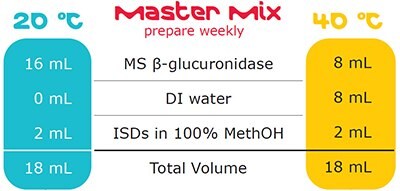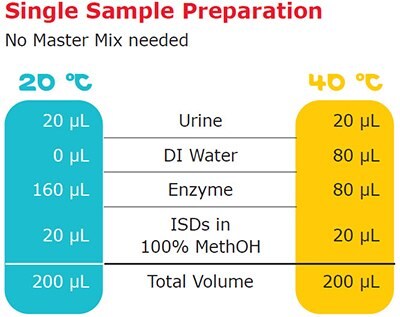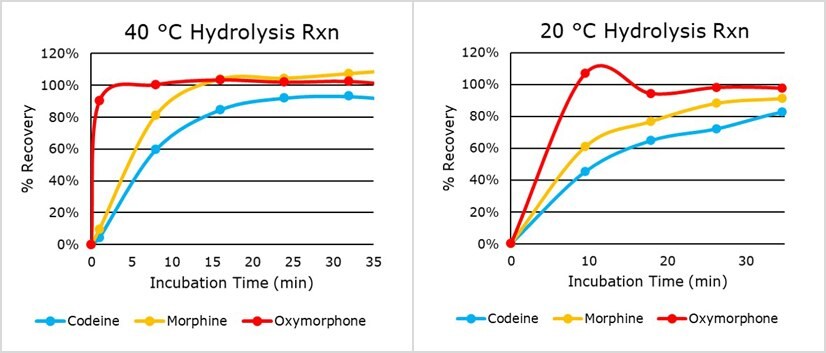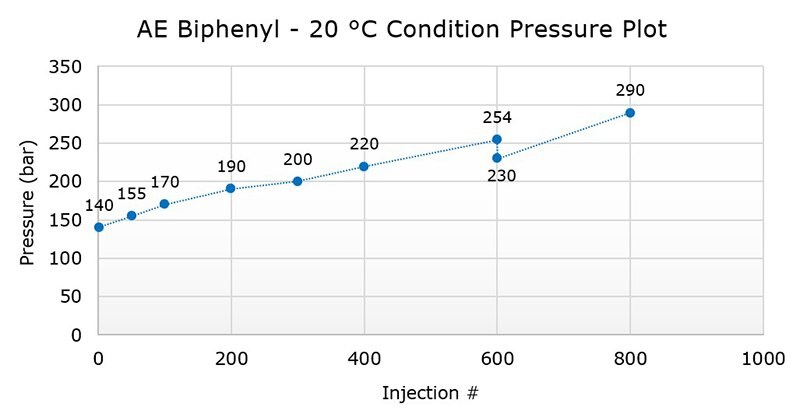Simple Urine Drug Screening with MS β-glucuronidase: Quick Start Guide and Demo Video
MS β-glucuronidase is specifically designed for medium to high-throughput, automated urine sample testing in clinical and forensic toxicology laboratory settings. This is achieved by a mass spec-compatible, pre-buffered, RT-stable product, that allows for a quick and simple walk-away workflow. Additionally, this product and protocol were co-developed using a human urine matrix to ensure that it overcomes the inhibitory characteristics seen in human urine.
MS β-glucuronidase is stable at 2-8 °C for long-term storage, or 2 months if stored at 20 °C. The enzyme also retains activity when stored in the Master Mix under ambient conditions for ≥ 7 days. The protocols as followed herein allow for recoveries >80% for a variety of analytes, including Codeine, Morphine, and Oxymorphone (Table 2). This Quick Start guide can be adapted to meet your specific needs or will function as-is for efficient hydrolysis of glucuronide metabolites in human urine. Due to the variety of laboratory instrumentation, conditions, drug types, and procedural requirements, assays should be verified or validated for the needs of the researcher or analytical laboratory. For additional reagents and resources, please visit our Drug Analysis Enzymes resource hub page.
MS β-glucuronidase Master Mix and Preparation
For routine testing, prepare a Master Mix† as in Figure 1 and store it for use as needed. Follow the workflow provided in Figure 2 to prepare urine samples for analysis. The enzyme is stable in the Master Mix for up to 40 days at room temperature. The stability of internal standards (ISDs) should be checked on a case-by-case basis. Allow the working Master Mix solution to reach room temperature (>20 °C) before use.

Figure 1.Preparation instructions for an MS β-glucuronidase Master Mix. All volumes can be scaled linearly to fit your needs. † Master Mix is not necessary for individual samples, occasional testing, or method development, to prepare samples without Master Mix create a reaction mix as in Table 1.
Routine Sample Analysis Stepwise Protocol
The following routine sample analysis stepwise protocol can be applied to any urine volume by maintaining the given proportions.
Protocol:
- Set autosampler to your desired temperature
- Pipette urine into vial, plate, or column
- Add MS β-glucuronidase Master Mix
- Transfer sample to autosampler ǂ
- After 16 min at 40 °C, or 30 min at 20 °C, inject hydrolyzed specimens

Table 1.Reaction mixture for single sample preparation (no Master Mix needed). ǂ If following SPE, filtration, or any protocol besides “Dilute and Shoot”, incubate reaction before continuing.
Quick Start Workflow:

Figure 2.MS β-glucuronidase Quick Start Workflow. This workflow is designed with “Dilute and Shoot” applications in mind. In addition, this workflow can be adapted for SPE, filtration, and alternate applications as needed.
Quick Start Workflow Sample Recoveries:

Table 2.Examples of recoveries observed by LC/MS for common analytes when following the Quick Start Guide.
Quick Start Time Course Sample Recoveries:

Figure 3.MS β-glucuronidase time course showing analyte recoveries for a range of drug-glucuronides in human urine under the 40 °C (left panel) and 20 °C (right panel) workflows per the Quick Start Guide.
For additional background information on using UHPLC/MS (TOF) for the detection of drugs and metabolites in urine following optimized enzymatic hydrolysis conditions, please visit our technical resource page for additional reagents and resources.
Impact of Dilute-and-Shoot Workflow on Column Pressure
MS β-glucuronidase enables a simplified, automated urine drug-testing workflow without the need for oven-incubation or post hydrolysis centrifugation. When higher sensitivity is a requirement, filtering or an extraction step may be added after room-temperature hydrolysis. To address questions about the impact that going to a dilute-and-shoot method can have on column pressure, our team of expert’s pressure-tested a column using the MS beta-glucuronidase quick start guide by monitoring backpressure while running repeat injections with human urine at 20 °C (Figure 4). The 20 °C workflow has the most enzyme content possible and represents the worst-case scenario. The reaction mix is available in Table 3, whereas the column type and parameters for the chromatography are available in Table 4.
Dilute and Shoot Workflow Master Mix
Column Pressure Test UHPLC Equipment Parameters
MS β-glucuronidase Dilute-and-Shoot Column Pressure Test Results
The test evaluates a “dilute-and-shoot” method. As such, the preparation described in Table 3 was injected directly onto the column without filtration or SPE. There were 800 repeat injections made under the pressure test conditions. Initial back pressure was 140 bar, and the column maintained an acceptable level of backpressure for the equipment throughout the 800 injections. The guard column was changed before injection 600; however, the backpressure did not fully recover, as captured in Figure 4 showing the pressure trend over the number of injections. While the backpressure is acceptable over the 800 injections, it is important to note that the quality of the chromatograms diminished considerably between 300 and 400 injections and did not recover with standard column cleaning methods.
Pressure Trend: AE Biphenyl - 20 °C Condition Pressure Plot

Figure 4.Backpressure measured over a number repeat injections under the conditions described above. The guard column was changed at injection 600.
MS β-glucuronidase Dilute-and-Shoot Column Pressure Test Takeaways
The Quick Start Guide is designed for dilute-and-shoot workflows but can be adapted to use filtration and SPE steps as needed. The Quick Start Guide instructs to dilute the urine 10x, which reduces protein and inhibitors commonly found in urine. This helps to make organic crashing and centrifuging unnecessary. When using the 20 °C workflow, we recommend changing the guard column after 300 to 500 injections. However, it is important to note that the appropriate guard column maintenance and replacement schedules are highly dependent on the system and samples being run.
The decision to use a dilute-and-shoot workflow will improve direct time and cycle time per sample, but it is not necessarily the optimal method in every case. Samples injected onto the column without filtration or SPE are cruder and may impact column life span. If a filtration or SPE step is needed, simply run the reaction at room temperature as directed in the Quick Start Guide directly on the media of choice and continue with the normal analysis. The benefits of a dilute-and-shoot workflow are clear as one considers direct and indirect time per sample. Ultimately, this is a decision that must be made by the customer with operational excellence in mind.
MS β-glucuronidase Quick Start Guide 40 °C workflow
An alternative method would be to use the Quick Start Guide 40 °C workflow. This uses half the enzyme amount while still using the same urine dilution factor. Once the reaction is started, it can immediately be loaded onto the heated (40 °C) autosampler. This workflow may improve the column lifetime and backpressures that were observed using the 20 °C workflow.
Precautions and Disclaimer
For R&D use only. Not for drug, household, or other uses. Please consult the Safety Data Sheet for information regarding hazards and safe handling practices.
To continue reading please sign in or create an account.
Don't Have An Account?